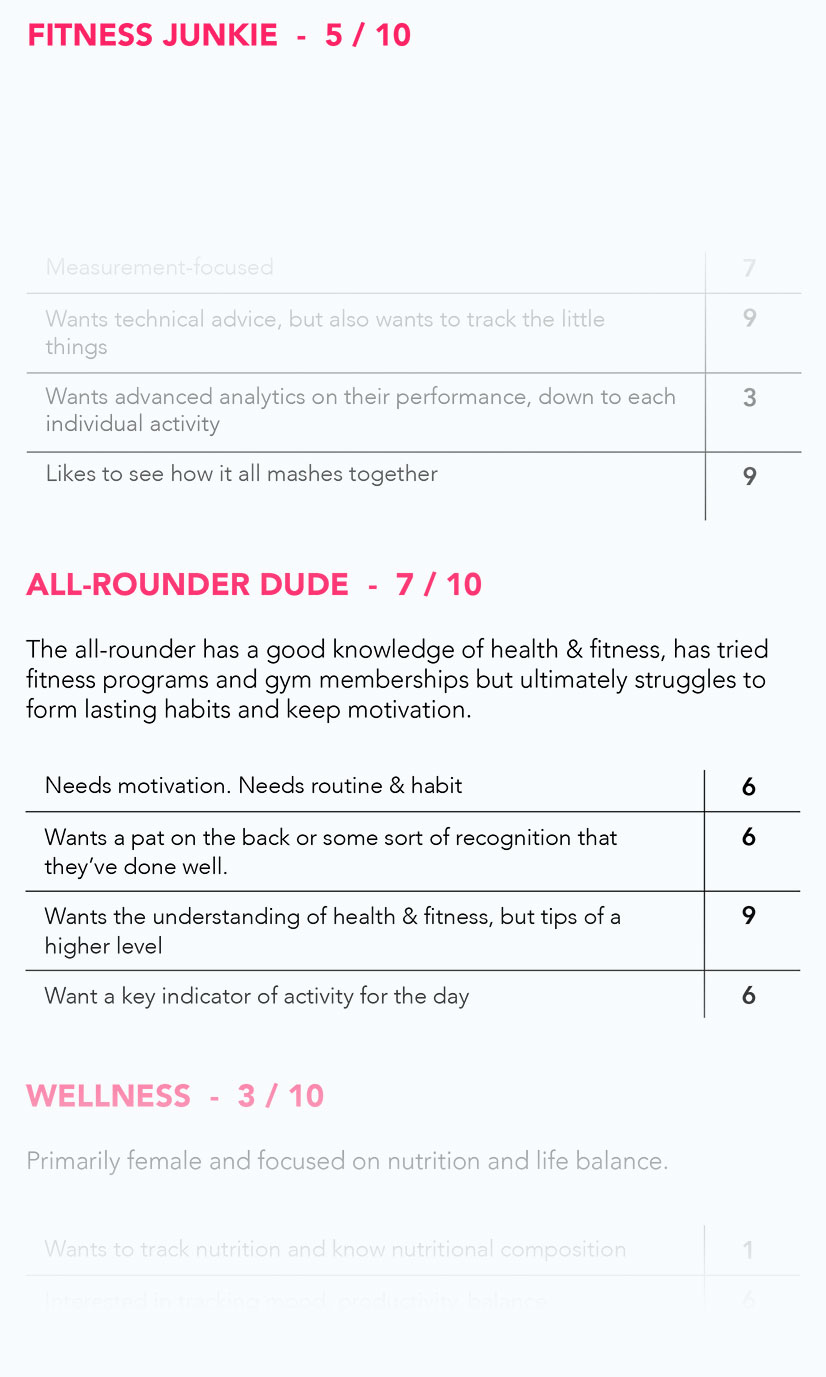We just released a pretty major update to BodyWise v2. It’s an update that was designed with an incredible amount of thought and conjecture.
I’ve had 109 conversations with users over the past three months. Bit by bit I’ve learnt what frustrated them in our apps and generally how they keep track of their health & fitness. Some things confirmed my own instincts and frustrations. Others were new and cut pretty deep.
Update product design – It started with the problem
Bad reviews.
Disgruntled users.
Bug notifications.
Lack of traction.
Those are business problems.
The real problem lay in the product not solving the problem that it set out to solve. Our product wasn’t significantly helping people to live happier and healthier lives.
You can talk about being better than other technology or doing so via increased motivation or through the product educating them about healthy living, but simply it’s all about solving the primary problem.
It’s a young product so we try not to be too hard on ourselves but that has to be our primary consideration as a company.
Planning an update
The situation:
- V1 had about 30,000 users over it’s 6 months. Logging data had a lot of friction, requiring you to log things manually. Lots of people loved the ability to track specific things that they couldn’t track with other apps but most gave up as technology evolved
- V1 was local to the device. There was no sign-up
- About 2,000 past users came across and signed up to V2
- We were averaging about 70 new users per day and daily active users in the hundreds
- Our average rating pre-update was close to 2/5. Many bad ratings due to FitBit/Jawbone UP bugs. Others due to clunkiness. It’s very easy to make fitness tracking cumbersome.
This update came about almost entirely from an exhaustive look at customer persona’s. Let me tell you as someone that has released a product that I wasn’t proud of that you need to look at your customer personas early on.
We fell into the trap of building a product too aligned to what we thought would be cool to use and week by week went further away from the problems that we were trying to solve for people wanting something better.
Dave (my co-founder) and I sat down one day and asked ourselves the hard questions. BodyWise v2 had been out for a few weeks. We launched saying that we’d help you get more out of your Fitbit or Jawbone UP. It was buggy as hell and didn’t really sync your data into BodyWise properly. That masked a gut feeling we started to develop that our product wasn’t good enough anyway.
- We broke our market into five personas
- We listed the things that they cared about (unique and otherwise)
- We rated how our product met those needs
- We gave each persona an overall rating out of ten
“So, we’ve got some seriously bloody work to do”.

Revisiting our customer personas and rating how our product fit specific needs was the best thing that we did. It’s a product design must in my opinion.
How to improve our product
We’re building a product for ourselves and personas that we’re very connected with which is a huge advantage for a small team. Dave’s a personal trainer that works closely with 40+ people every week using his knowledge and skill to help them to live healthier and happier lives.
That meant that we had a pretty good idea of where our product needed work before we looked at the personas. For us what the personas did was give us focus.
Food tracking:
You could track food through BodyWise, but it was painful and was down to you knowing and logging the nutritional intake of your food and drink. We explored how do people track their diets. MyFitnessPal is the dominant food tracking app but it has a closed API and the long-term engagement is pretty shocking.
We spoke to nutritionists, health coaches, wellness bloggers, our users and active users of MyFitnessPal. We decided on a few things:
- Barcode scanning and logging of individual food items is the easiest habit of all to break
- Once you break it, you’re unlikely to start again for a long time
- Logging of food and ones nutritional intake is the hardest problem in our space to solve
- There is so much friction in the current options of scanning a barcode or searching through a database of foods and guessing which one is the closest match to what you had
- For an app like ours with ambitions to provide maximum meaning to your health & fitness data, having nutritional data is crucial
- Our app is already pretty big. If not done right, a new food tracking feature could really bloat it
- It’s a problem worth solving

We started with a number of concepts and filtered it down to a simple counter system. We loved it. We showed it to users and they loved it, like seriously loved it.
We went through a few iterations. We played around with colours, positioning, the size of buttons for tapping.
Loading
The finished feature was the most stripped back food tracking out there? Have veggies with lunch. Tap veggies once. A few bananas for morning tea? Tap it a few times. There’s no real right or wrong. Did you have it or didn’t you? The simple act of tracking creates mindfulness and the solution was frictionless. Testing revealed that users felt it was a much less stressful experience than using other food trackers where specifics mattered and there was friction in getting those specifics.
Workout tracking:
Again, this one pissed us off for months. We knew we didn’t have it right. Users wanted to be able to distinguish between types of workouts. If I go for a 15 minute run and hit the gym for 30 minutes that night, I don’t want to simply say I had a workout duration of 45 minutes that day. I want to get the pat on the back for doing something positive twice in one day.
Loading
Jerrold engineered a solution that let you track as many workouts in a day as you like, all combining to a total grand tally of your duration. We can split out our analysis by activity as well. That means we can do things like compare your happiness on days that you do yoga, compared to days where you do bugger all.
With users tracking workouts reliably we can match that with other data too. We might be able to predict your likelihood of working out the day after drinking alcohol. We can step in and challenge you to do something you wouldn’t have otherwise done.
It’s not perfect in that technology doesn’t log it all for you but for all but the simplest forms of exercise that you bring your phone with you, it’s a hard problem to solve. We’ll get better at that. Can’t do it all at once right?
Log multiple days at a time:
One of the major barriers to long-term engagement with our app was the amount of friction that users had if they missed tracking it on one day.
An app thats only useful if you use it every single day is suicide in most cases. Certainly for ours, we needed to make it easier to log in a few times a week.
We did a lot of development and testing around the ability to easily scroll through past days data, add it all at once or even just a simple edit of a previous days data
Decluttering:
This one was a hard one to validate with any data. Those that grew tired of logging their health with our app generally couldn’t put a finger on why.
I had a gut feeling that it was because of a cluttered result logging screen.
Again because we’re making the product for ourselves, we picked up that many of the things that you log with your health, you don’t log on a daily basis.
Diet, activity and mood are all things that change and can be influenced on a daily basis. What about your weight, body measurements or strength stats.
I felt that users whether they knew it or not would grow frustrated with glossing over the same questions 80% of the time. Even though I want to use the app to track my weight, I don’t want to do it every day.
The challenge was to make the things that your presented to track on a daily basis, more relevant to your day.
We experimented with simple show/hide toggles but that still leaves a certain amount of clutter.


We looked at taking certain body-related metrics out of the enter results screen and moving them into a fortnightly prompt and push notification to log them.
We tested it but felt that it removed too much power from the user.
After seven variations we decided on splitting out daily metrics and body metrics into separate tabs. The result was that my own personal results screen almost halved in size.
Loading
Other changes:
There were things that bugged users. They messaged us on Facebook and wrote us emails with encouragement and sometimes frustration but we worked out the bugs that pissed them off.
We’d used up a lot of their good graces with some Fitbit & Jawbone UP syncing issues so we felt it was important to address the things that they wanted fixed and look after our relationship with them.
Overall we included about 20 bug fixes and minor features that made for a generally far smoother and easier experience.
So, what now?
We try to raise some money so we can work hard on our engineering. The UX needs work but Healthkit integration is more important. There’s still a few bugs. We’ve got the whole personal training product that I haven’t even mentioned. We’ve got a lot to do. We need to raise money. This update is a MASSIVE step forward but we’re still moving too slow for my liking.
We live by user retention.
Are people using our new features?
Are their average session times increasing?
How does user retention differ between users of different versions?
Do our average app store ratings improve?
How does each persona feel about the app post-update?
Is our app better helping to solve the problem that we set out to solve
Lets see what happens!

1 thought on “Making a better app – a look at our BodyWise product design process”